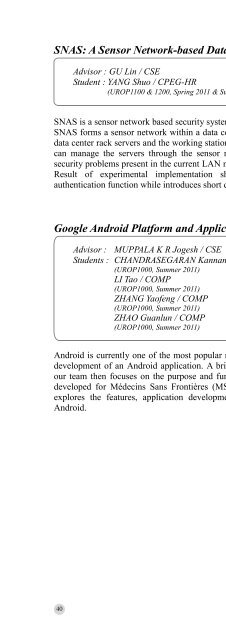UROP Proceedings 2010-11
UROP Proceedings 2010-11
UROP Proceedings 2010-11
You also want an ePaper? Increase the reach of your titles
YUMPU automatically turns print PDFs into web optimized ePapers that Google loves.
Desired Affective States of People with AnhedoniaAdvisor : YIK Michelle / SOSCStudent : HO Yiu Nam / PHYS-PP(<strong>UROP</strong><strong>11</strong>00 & 1200, Fall <strong>2010</strong> & Spring 20<strong>11</strong>)Anhedonia is generally defined as the diminished capacity to experience pleasure (Meehl1962; Rado 1962), with physical anhedonia as the lack of pleasure in the engagement ofvarious sensory stimuli, and social anhedonia as the lack of pleasure in the engagement ofvarious social activities. Past research has obtained positive correlation between desired andactual affective states on the affective circumplex with normal, healthy university students(Kampfe & Mitte, 2009). However, no studies were conducted to examine the relationshipbetween the desired affect state of anhedonics and anhedonia. This study furthers ourunderstanding of anhedonia - is anhedonia driven by the incapacity to experience positiveaffect or the lack of motivation to seek positive affect.Facial Expressions of EmotionsAdvisor : YIK Michelle / SOSCStudent : LI Kwan Ho / ECON(<strong>UROP</strong><strong>11</strong>00 & 1200, Spring 20<strong>11</strong> & Summer 20<strong>11</strong>)During the last two decades, there have been fierce debates on how people perceive emotionsin facial expressions. Russell (1987) suggested that perception of emotions is not absolute,meaning that the process of perceiving emotion could be influenced by the context, such asother facial expressions in an experiment. In this project, I first reviewed Russell’s perspectiveon facial expressions of emotions and his views on the effect experimental methods onperceiving emotion in faces. Then, I tested if the context influenced the perception of anemotion from faces by asking subjects to recognize emotions from faces in a questionnairestudy. Results showed that the emotion perceived in a face depended on the prior facesviewed, implying the significant effect of context in emotion perception.The Relationship between Social Behaviors and Hedonic Deficits amongUniversity StudentsAdvisor : YIK Michelle / SOSCStudent : WAN Hanzhe / FINA(<strong>UROP</strong><strong>11</strong>00, Summer 20<strong>11</strong>)Anhedonia has been the subject of numerous studies since it was first observed as one of thedefining characteristics of schizophrenia. It has been widely accepted that anhedonia reflectsa deficit in anticipatory or “appetitive” pleasure, resulting in a failure of motivation andbehavior directed towards obtaining reward (Germans & Kring 2000). Plenty of studies havebeen conducted to examine the relationship between anhedonia and affective experience, butonly a few were conducted to study the influence of anhedonia on social behaviors. In theproposed study, I examine the role of anhedonia in romantic relationships and academicperformance among university students.83



